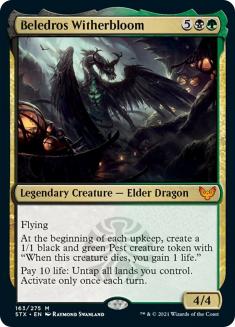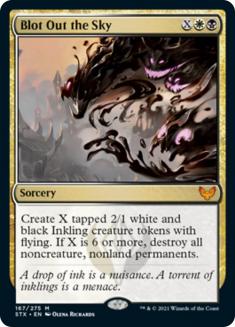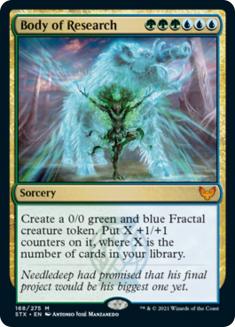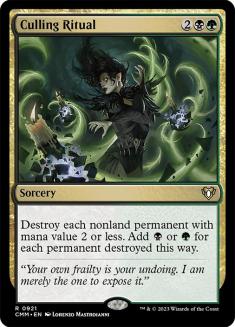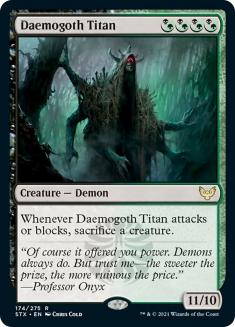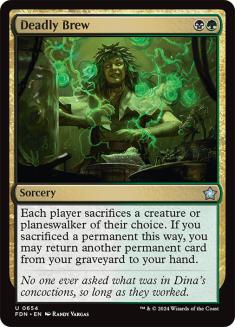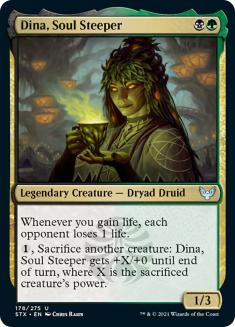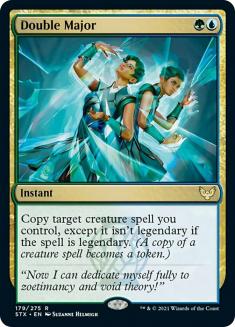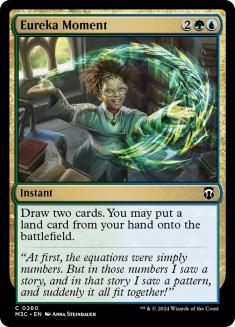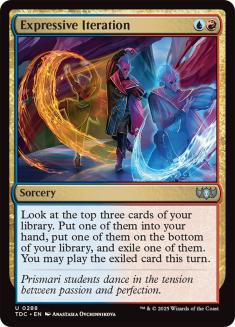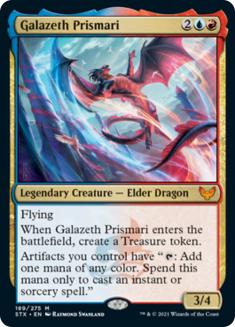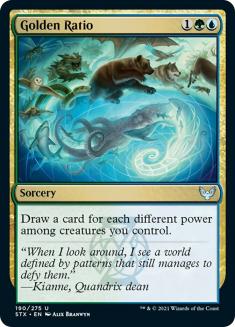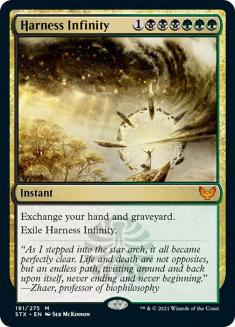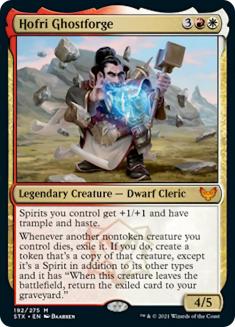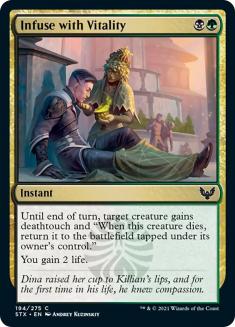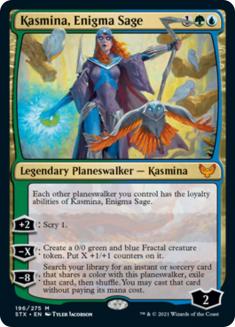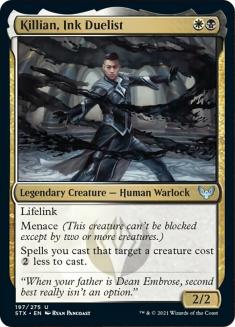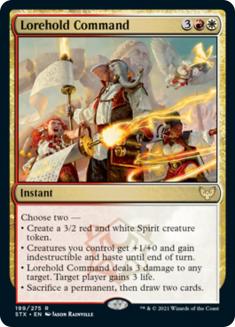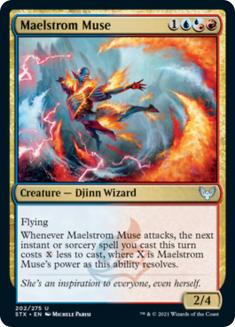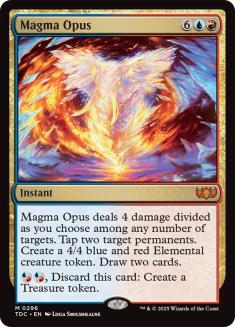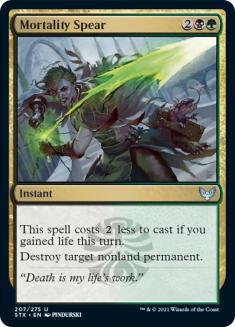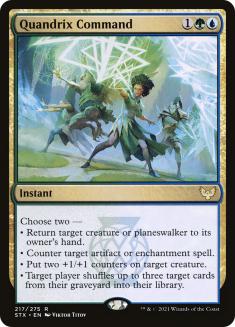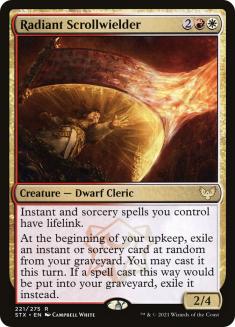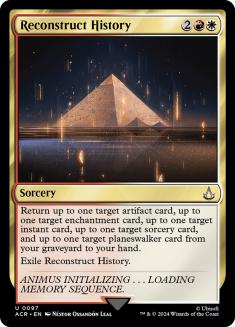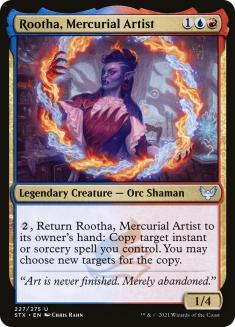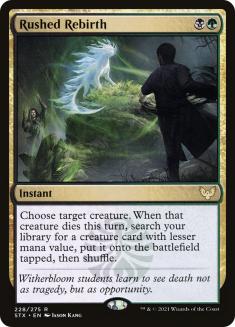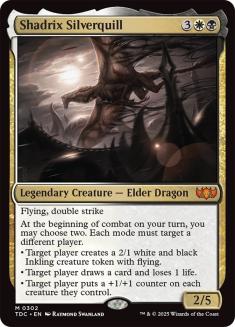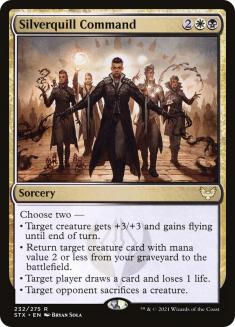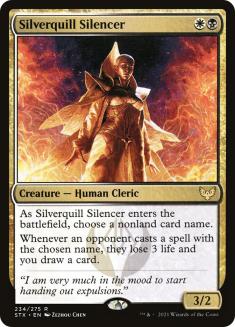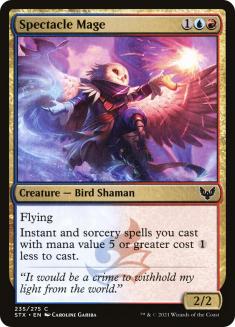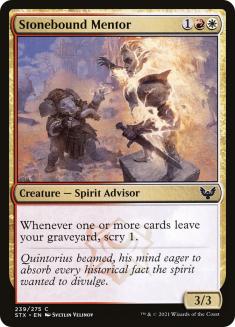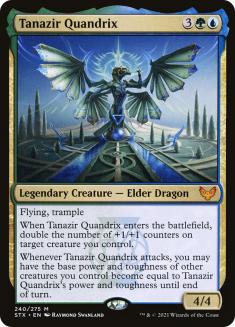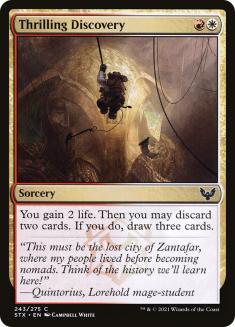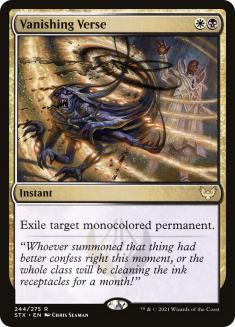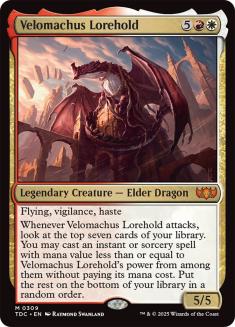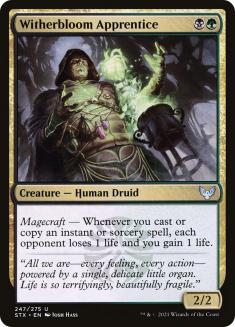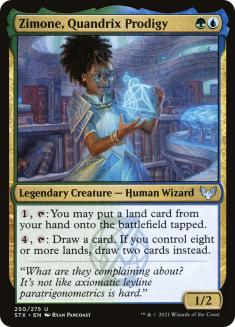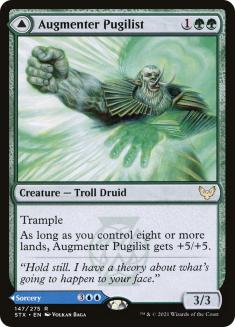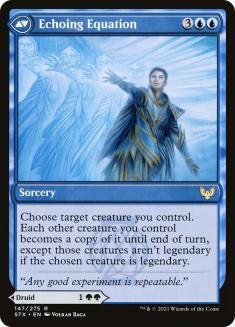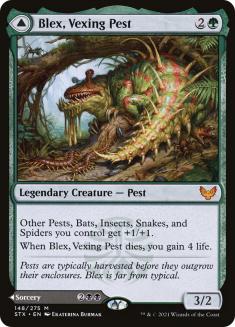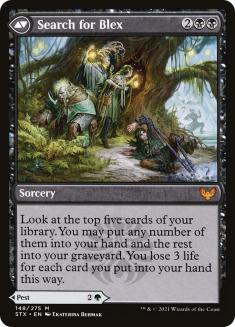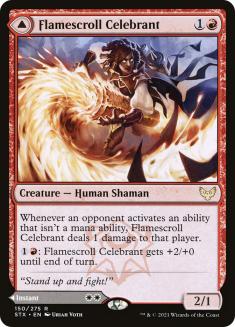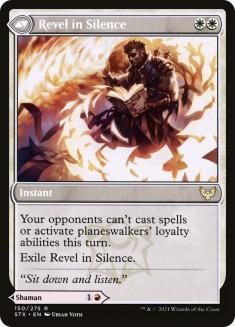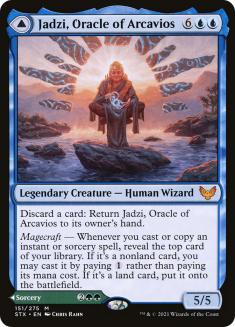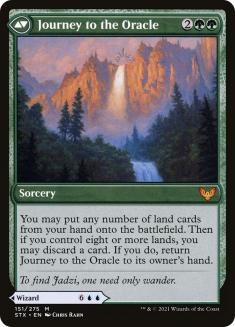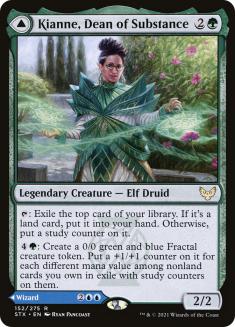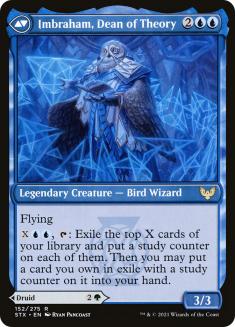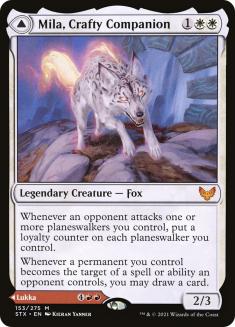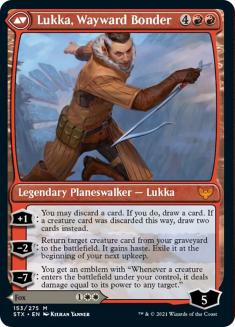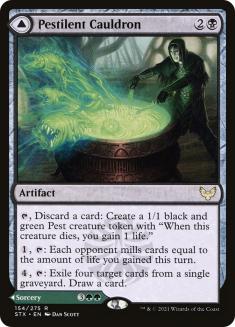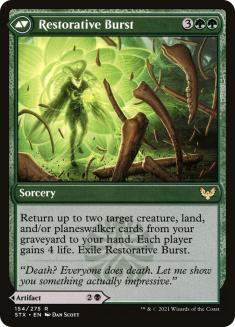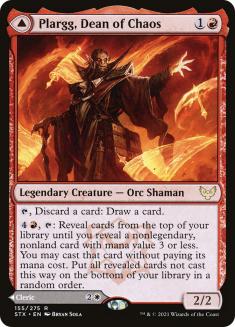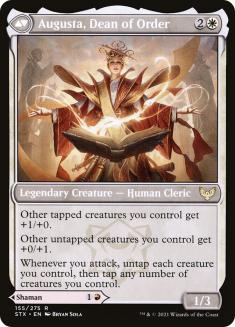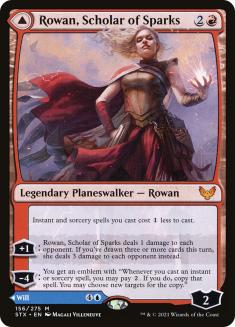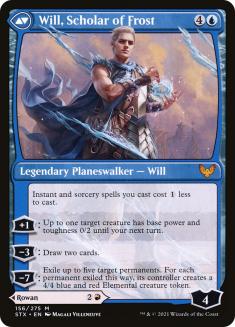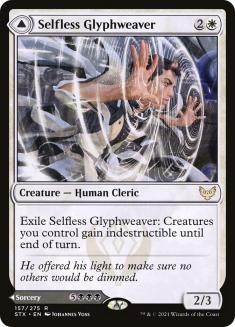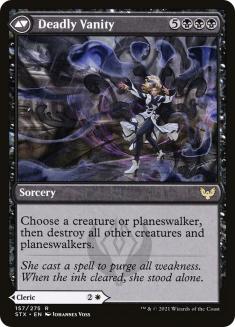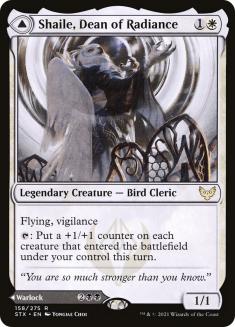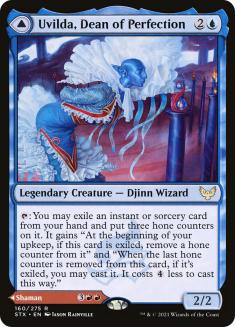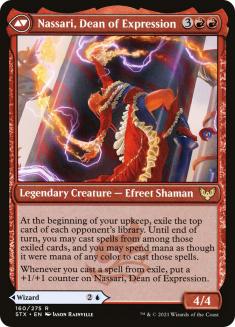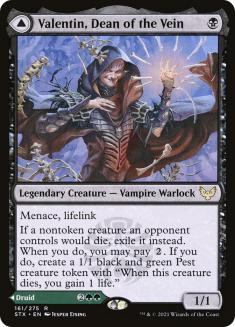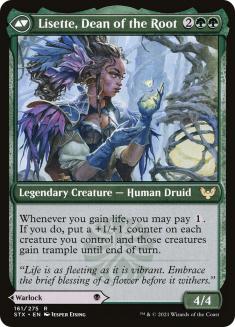Yesterday, we looked at the delicious appetizer that was the monocolored cards, artifacts, and lands in Strixhaven. This time, we’ll get to the mouth-watering, flavor-drenched main course of the multicolored cards and modal DFCs. Even though this dish isn’t cooling off anytime soon, let’s dig right into it.
Multicolored
The Witherbloom college founder knows that her students are going to gain some life, so paying ten of it to untap all the lands isn’t really that much of a payment.
Taking a page from Martial Coup, Blot Out the Sky is an excellent method of building an army while getting rid of a bunch of things that are making your life miserable. The card demonstrates that clever design doesn’t have to be overly complicated.
Some of the naysayers will give you the “no evasion” song and dance, but we’re talking about a creature that potentially has 80-some counters on it. Also, that’s what Rogue’s Passage is for. Giving it trample is also a solid idea. Cast The Ozolith first for the kind of safety valve that will eventually wreck somebody’s day.
In Commander, Culling Ritual will get out of hand, especially in situations where there is a swarm of tokens on the battlefield. Even when you’re only going to get five or six mana out of it, that’ll fuel an Overwhelming Stampede rather easily.
An 11/10 for four mana? That’s saucy enough, but thinking the triggered ability is a drawback is just silly. There will be situations when you won’t be able to attack or block with it, but there will be more when you’re sacrificing a creature for extreme value (like you have Grave Pact on the battlefield).
I still long for the days when Demons hurt you if you didn’t do what they wanted. A four-mana 7/6 is pretty strong. It’s going into a deck that wants to sacrifice creatures, like Karador, Ghost Chieftain. When you have to sacrifice it, either to its own ability or to pay for another spell or ability, it more than replaces itself.
The only downside to Deadly Brew is that you can’t bring back the thing you sacrificed. Other than that, it’s a three-for-one for two mana, which is solid value.
This is a compelling design. It’s not so over the top as Vito, Thorn of the Dusk Rose (although I guess you can play Vito in a Dina deck). You’ll get some mileage out of Dina, but you’ll have to do a little work with her. Of course, I love my sacrifice outlets (especially those that don’t tap). Sacrificing creatures to make Dina turn from a small creature to something deadly is right up my alley.
Okay, the absurdity that can come of Double Major is the kind of things dreams are made of. Getting an extra copy of your command can be outright silly. The first one that came to mind for me was Yarok, the Desecrated. Any commander with triggered abilities is going to pay remarkable dividends. Two Tatyova, Benthic Druid? Two Chulane, Teller of Tales? Yikes.
My dream play with this card — which I suspect will be quite useful under normal circumstances — will be to respond to someone attacking by dumping a Maze of Ith onto the battlefield. Otherwise, I’ll just be drawing cards and ramping. This card could have been a sorcery and it would still be playable. All that said, I find it an uninspiring design.
The thing I see about Expressive Iteration is that it’s a way for Prismari to have ramp, via the exiled card. This somewhat rare ability will have you casting those big spells just that much faster.
With Galazeth, it’s nice that you don’t have to sacrifice your Treasure tokens in order to get mana out of them. The school is about casting big instants and sorceries, like Magma Opus; Galazeth makes it easier to do so.
This is the better part of the design space that they went into with Quandrix. Yes, it draws cards, which blue is the best at, but it’s a unique effect. Quandrix is obsessed with numbers, so this card makes perfect sense.
Oh, the possibilities. Unlike Praetor’s Counsel, you’ll need something else to give you unlimited hand size, but you’ve probably prepared for that eventuality. Outside-the-box uses include saving your big graveyard from a Bojuka Bog or gaining a pile of life with a Sword of War and Peace trigger.
Once you’ve unlocked the secrets and raised the ancient Spirits with Hofri, they become most battle-worthy, getting +1/+1, trample, and haste. Then the triggered ability is kind of obscene. You’re not really gambling much by exiling the creature to create a copy (not that you have much choice), since it just goes back to the graveyard if the token leaves. Red or white cards that play well with Hofri include Malignus and Serra Avatar. On the latter, since you control both triggers, you can put Serra Avatar’s on the stack first and then Hofri’s, which will resolve first. Serra Avatar will still get shuffled in when the token goes away, but you don’t need a trample, haste creature with power and toughness equal to your life total to stay around all that long.
I love the “when this dies, return it to the battlefield” mechanic, which I believe we first saw in False Demise. The card’s best value is when you can kill something important that an opponent controls, but you still also just use it to save your best creature from a battlefield sweeper.
The most compelling part of Kasmina for me is that those War of the Spark planeswalkers without a native ability to add counters now do. It’ll take a while for Kasmina to get to eight loyalty, but if you do, you’re in for a big payday. Time Stretch shares a color with Kasmina, right?
This is one that most folks are going to have to read twice, because it makes all spells that you cast targeting creatures cheaper, not just your own. That means that both strive costs will be lower and your targeted removal cheaper. Having lifelink and menace on a 2/2 for two mana isn’t all that bad, either.
Maybe too pricey to see lots of play, but I’m okay with spending that much for the second mode, with the most significant bit making my creatures indestructible until end of turn.
One of the challenges of making the big spells work in Prismari was that you can’t just have permanents that reduce mana costs so much. Maelstrom Muse is a clever way to provide that boost, but only conditionally. First you put some Equipment on it to make it bigger and more combat-worthy, then profit.
The set’s best wordplay is on a saucy card. The four damage will take out some smaller utility creatures or a bothersome commander like Kediss, Emberclaw Familiar (and maybe its frequent partner, Ardenn, Intrepid Archaeologist as well). Tapping two permanents — not just creatures — can be either an offensive or defensive move. The 4/4 creature is pretty straightforward; drawing two cards is a cherry on top of this delicious sundae.
Already close to good enough to play without the cost reduction, Mortality Spear’s condition for saving two mana is pretty easily met.
The two modes that’ll be most used here are bouncing a creature or planeswalker and countering the artifact or enchantment spell. The limitation on what it can counter downgrades it from completely bonkers to thoroughly useful.
A cool combination of Soulfire Grand Master (or Firesong and Sunspeaker if you prefer) and Charmbreaker Devils, Radiant Scrollwielder will occasionally be a beating for your opponents and sometimes give that beating to you, but it will always be entertaining.
Another strong example of Lorehold doing what Lorehold does — bringing the past to life. Even if you don’t go five-for-five, you get lots of value.
You can use Rootha’s ability offensively or defensively. On the offensive side, you copy a damage spell like Crackle with Power. Defensively, if you’re in a counter war, you can get another copy of the counterspell you need to win that battle.
The cool thing about Rushed Rebirth is that the creature you target doesn’t have to be yours. If someone else’s large beast is about to die, you can search up something big of your own. Of course, you don’t have to wait. The card has black in its cost, so you can make it part of your sacrifice suite for some pretty extreme value.
It’s in the colors of reanimation, so there’s quite a bit you can do with Shadewing Laureate. I’m going probably work it into a deck with Puppeteer Clique in order to remove the persist counter. Pair with Luminous Broodmoth and you have stuff happening whenever one of your creatures dies.
From the beginning of design for what became Silverquill in Commander, politics was an important aspect. Some of that seems to have spilled over into the main set with the college’s founder. You have to target a different player with the beginning of combat trigger, but you can certainly choose to put +1/+1 counters on all the creatures of the player that has none. I’m fond of this design because it lets you make what might be some incredibly nuanced decisions.
My suspicion is that the last two modes (draw a card; an opponent sacrifices a creature) are the ones that will be most frequently used in Commander, although there’s certainly some value to reanimating the kind of small creature that frequently gets killed, like Blood Artist or Suture Priest.
What is the best card to name with Silverquill Silencer, and why is it Rograkh, Son of Rohgahh?
From the very beginning of vision design, there was an idea that Prismari was going to be about big spells (although we didn’t know what it would be called at that point), and it’s cool to see that idea lasted through all the iterations of development.
Stonebound Mentor reflects this set just dripping with flavor. The card isn’t particularly powerful, just useful in a somewhat narrow band. I’m pleased to see designers go for more focused things than just cards you’ll play in every deck of the colors (like, I must admit, Eureka Moment).
You’ll likely be playing Tanazir in a +1/+1 counters deck. Many of your creatures might have base power of 0 or 1 and get buffed by counters. When Tanazir attacks, they’re suddenly quite a bit larger, maybe lethally so. Of course, you can always get a few counters on Tanazir itself and then double them for a one- or two-shot commander damage kill.
When you have an immense creature like Lord of Extinction, people will try to kill it. When they do, you have this great ejector seat in Tend the Pests. Four or five Pests that are going to give you life if they die seems like a non-terrible trade.
This card, in both its ability and name, captures what Lorehold does. Discovery is the name of the game.
I’m on the fence if there will be enough significant monocolored permanents in our environment to make Vanishing Verse worth playing. The partner commanders from Commander Legends might singlehandedly be worth it. It could be a dead card or it could be the one that gets you out of a really tight spot. I think I’ll give it a shot and be willing to be wrong.
Casting spells for free is quite strong, even within Velomachus’s limitations. Of course, you just need a Sword of Light and Shadow to make Velomachus true Elder Dragon size, with the accompanying opportunity to cast larger free spells. Haste makes the Lorehold founder quite dangerous.
This is exactly the kind of novel new card that we want to see from Boros/Lorehold. The ability is good in a narrowly focused way. You still need to get in for a decent amount of damage to get the reanimation going. To me, the card name evokes a Minotaur, not a Spirit, but I get where the creative team was going.
The inexpensive card that goes infinite with Chain of Smog, Witherbloom Apprentice is also simply one of those incremental advantage cards. Even if you’re not playing the combo, it’s going to give you value while you’re just doing the things you normally do in the game.
Zimone is a good card and will likely be in or lead strong decks. Here’s my problem: it’s boring. It does exactly what you expect the colors to do. There was plenty of design space to explore in Quandrix, and this just isn’t it. I’m really disappointed at the missed opportunity.
Top 3:
- Double Major
- Hofri Ghostforge
- Tanazir Quandrix
Grade: A+
It’s no surprise in this set that features the five two-colored colleges that the multicolored card section is dense with power and excitement.
Modal DFCs
An 8/8 trampler for three mana is something else, even if it’s conditional. You’re in green, so you’re getting to those eight lands in short order. Echoing Equation, the back face, is even more deadly, giving you the opportunity to turn every creature you control into a copy of even a legendary creature (without any of them going away).
When Strixhaven was in development, we were already talking about changing the commander dies trigger. If memory serves correctly, we had already worked out all the details while I was still in the building (and we decided to wait to announce until the online programming teams could catch up; you want avoid as much as possible the game to operate differently online that it does on paper). I imagine Blex owes his lifegain trigger to that decision. The back face, Search for Blex, is kind of misnamed since you already know where Blex is (although I suppose that in 60-card formats, the search could indeed turn up Blex).
Modal DFCs are a creative way of getting into three-color identities (or maybe even four-) without the weight of needing all your colors at once. Extus makes hay of the creature cards in your graveyard with all the excellent enters-the-battlefield triggers, like Noxious Gearhulk and Ashen Rider. On the back face, Awaken the Blood Avatar gives you something to do with those tokens from Endrek Sahr, Master Breeder, keeping everyone else’s battlefields clearer of creatures. Add Dictate of Erebos and suddenly the sides aren’t even at all.
In the tradition of Burning-Tree Shaman (an underplayed Hidden Gem), Flamescroll Celebrant will deal out well more damage than you expect it to. The back face, Revel in Silence, might see some play at various power levels. It can prevent your opponents from counterspelling your important pieces, or it can simply shut down one of their turns. The face that you have to exile Revel in Silence keeps it in check, unless you put it on Isochron Scepter.
There has to be some way of casting your whole deck in a zero-nonland-permanent version. Even with permanents, you’re going to get ridiculous value out of every instant or sorcery you cast. Late-game ramp spells go from useless to potentially game-breaking. The back face, Journey to the Oracle, is four-mana ramp of a different kind. Instead of being a regular ramp spell, it will have more use in some kind of landfall on top of card draw combo.
Kianne’s abilities seem to be more built for Limited environments. You’d otherwise have to count on Imbraham, Dean of Theory, the back face, to get those cards back. If you activated Imbraham’s ability, you can always activate for X=0 if you already have exiled cards with study counters on them.
I love the design of this card. It stops chip damage to your planeswalkers, and if you have multiples, it gets their loyalty counters high in short order. Adding the taxing effect of drawing a card when spells or abilities target your permanents means that you get replace everything that gets destroyed with targeted removal. In the case of activated abilities like Maze of Ith, you’ll be drawing into answers more quickly. Then we get to the back face, Lukka, Wayward Bonder. Getting to Lukka’s ultimate, which gives you an emblem in the form of Warstorm Surge, will be a little harder, but once you do, it’s close to game over. I’d be content to loop the first two abilities, discarding a creature card for the +1 and then reanimating it for the -2. It’ll be even better with a sacrifice outlet in there so that your creature won’t be exiled.
Of the three activated abilities, we’ll see the first one occasionally and well more of the other two. The second might be occasionally devastating, since there are some large lifegain possibilities in the two colors, like Momentous Fall on Lord of Extinction. The third is the one with the long-term value, providing card draw along with graveyard control. As playable as the front face is, it’s unlikely we see the back face, Restorative Burst, too often. The most likely scenario is drawing it on a later turn and needing one of those cards in the graveyard to win.
Rummaging for just a tap is a great way to get to the business pieces of your deck. We’re less likely to see the second ability played that often in Commander, given the relatively high activation cost and low payout. The back face, Augusta, Dean of Order, creates a compelling choice for you; do you want to untap your attackers so they’re around to play defense or do you want to tap them again to give them a power boost?
Rowan can be an impact card relatively early in a game. It’s not going to take long to get to the four loyalty counters that get you the spell-copying emblem. Knowing that you’re in Izzet/Prismari means you’ll be copying big ones very soon. Will, Scholar of Frost, has a bit of a different take, slowing things down a bit. His -7 ability allows you to take care of some problematic permanents in a fashion that isn’t all that dangerous to you (unless all five of them happen to belong to the same player).
You’ll need whichever face you decide to play only once. Selfless Glyphwielder exiles itself to activate and make your team indestructible, so that’s a one-way street. Deadly Vanity is going to destroy all other creatures and planeswalkers save for one you choose, which should be enough to get you where you want to go (and at eight mana, it’ll be expensive). Of course, after you cast Deadly Vanity, it’ll be in your graveyard face up as Selfless Glyphweaver, which you can then regrow or reanimate.
Shaile’s activated ability is nice if you’re playing something that puts lots of creatures onto the battlefield for you, like Avenger of Zendikar or Storm Herd. The back face, Embrose, Dean of Shadow, it less useful for its activated ability than its’ triggered one: drawing a card whenever one of your creatures with a +1/+1 counter on it dies. I know fellow RC member Toby Elliot will be sad that he can’t play this in his Grakmaw, Skyclave Ravager deck.
Uvilda’s pseudo-suspend ability with foretell overtones lets you pay less for a big instant or sorcery for the simple investment of time. It also protects the card from discard effects. Note that the card that you exile has the abilities, so they’ll still work if Uvilda goes away. You might want to let that happen in order to cast the back face, Nassari, Dean of Expression. Remember that you’ll put a counter on Nassari whenever you cast a spell from exile (like with foretell or suspend), not just the ones you cast off of your opponents.
Exiling opponents’ creatures is extremely powerful, even without the triggered ability to create Pest tokens. The back face, Lisette, Dean of the Root, is also strong. For the small cost of just one mana after gaining life, you can make your creatures permanently larger as well as giving them trample. There are obvious alpha strike connotations for giving trample to your whole squad.
Top 3:
- Augmenter Pugilist // Echoing Equation
- Extus, Oriq Overlord // Awaken the Blood Avatar
- Rowan, Scholar of Sparks // Will, Scholar of Frost
Grade: A
From top to bottom, this is excellent use of the modal DFC design space. The cards are compelling and you have to do a little work to get the best mileage out of them.
On the whole, Strixhaven gets an A and we haven’t even gotten to the Strixhaven Commander cards yet! The impact on Commander will be immediate, as deck brewers have a great deal to work with in some thought-provoking directions. Those of us who have a suite of existing decks also have quite a bit to choose from. Tune back in next time as we continue Strixhaven preview season with the Commander product you won’t want to miss out on.
Visit my Decklist Database to see my Signature Decks, the Chromatic Project, and more!


